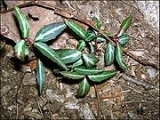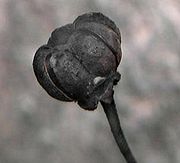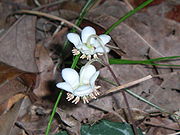
Chimaphila maculata
Encyclopedia
Chimaphila maculata is a small (10-25 cm tall), perennial
evergreen
herb
native to eastern North America
and Central America
, from southern Quebec
west to Illinois
, and south to Florida
and Panama
.

 It has dark green, variegated leaves 2-7 cm in length, and 6-26 mm in width. The variegation of the leaves arises from the distinct white veins contrasted with the dark green of the leaf. The stems emerge from creeping rhizome
It has dark green, variegated leaves 2-7 cm in length, and 6-26 mm in width. The variegation of the leaves arises from the distinct white veins contrasted with the dark green of the leaf. The stems emerge from creeping rhizome
s. The nearly round flower
s, which appear in late July to early August, are found on top of tall stalks. They are white or pinkish and are insect
pollinated
. The flowers mature to small (6 to 8 mm in diameter) capsules baring the seeds of the plant, which are dispersed by the wind.
It can be found in sandy habitats, well-drained upland forests, oak-pine woods, and similar mesic habitat
s. It is very tolerant of acidic soil.
Perennial plant
A perennial plant or simply perennial is a plant that lives for more than two years. The term is often used to differentiate a plant from shorter lived annuals and biennials. The term is sometimes misused by commercial gardeners or horticulturalists to describe only herbaceous perennials...
evergreen
Evergreen
In botany, an evergreen plant is a plant that has leaves in all seasons. This contrasts with deciduous plants, which completely lose their foliage during the winter or dry season.There are many different kinds of evergreen plants, both trees and shrubs...
herb
Herb
Except in botanical usage, an herb is "any plant with leaves, seeds, or flowers used for flavoring, food, medicine, or perfume" or "a part of such a plant as used in cooking"...
native to eastern North America
North America
North America is a continent wholly within the Northern Hemisphere and almost wholly within the Western Hemisphere. It is also considered a northern subcontinent of the Americas...
and Central America
Central America
Central America is the central geographic region of the Americas. It is the southernmost, isthmian portion of the North American continent, which connects with South America on the southeast. When considered part of the unified continental model, it is considered a subcontinent...
, from southern Quebec
Quebec
Quebec or is a province in east-central Canada. It is the only Canadian province with a predominantly French-speaking population and the only one whose sole official language is French at the provincial level....
west to Illinois
Illinois
Illinois is the fifth-most populous state of the United States of America, and is often noted for being a microcosm of the entire country. With Chicago in the northeast, small industrial cities and great agricultural productivity in central and northern Illinois, and natural resources like coal,...
, and south to Florida
Florida
Florida is a state in the southeastern United States, located on the nation's Atlantic and Gulf coasts. It is bordered to the west by the Gulf of Mexico, to the north by Alabama and Georgia and to the east by the Atlantic Ocean. With a population of 18,801,310 as measured by the 2010 census, it...
and Panama
Panama
Panama , officially the Republic of Panama , is the southernmost country of Central America. Situated on the isthmus connecting North and South America, it is bordered by Costa Rica to the northwest, Colombia to the southeast, the Caribbean Sea to the north and the Pacific Ocean to the south. The...
.


Rhizome
In botany and dendrology, a rhizome is a characteristically horizontal stem of a plant that is usually found underground, often sending out roots and shoots from its nodes...
s. The nearly round flower
Flower
A flower, sometimes known as a bloom or blossom, is the reproductive structure found in flowering plants . The biological function of a flower is to effect reproduction, usually by providing a mechanism for the union of sperm with eggs...
s, which appear in late July to early August, are found on top of tall stalks. They are white or pinkish and are insect
Insect
Insects are a class of living creatures within the arthropods that have a chitinous exoskeleton, a three-part body , three pairs of jointed legs, compound eyes, and two antennae...
pollinated
Pollination
Pollination is the process by which pollen is transferred in plants, thereby enabling fertilisation and sexual reproduction. Pollen grains transport the male gametes to where the female gamete are contained within the carpel; in gymnosperms the pollen is directly applied to the ovule itself...
. The flowers mature to small (6 to 8 mm in diameter) capsules baring the seeds of the plant, which are dispersed by the wind.
It can be found in sandy habitats, well-drained upland forests, oak-pine woods, and similar mesic habitat
Mesic habitat
In ecology, a mesic habitat is a type of habitat with a moderate or well-balanced supply of moisture, e.g., a mesic forest, a temperate hardwood forest, or dry-mesic prairie. Compared to a dry habitat, a mesic habitat is moister....
s. It is very tolerant of acidic soil.

